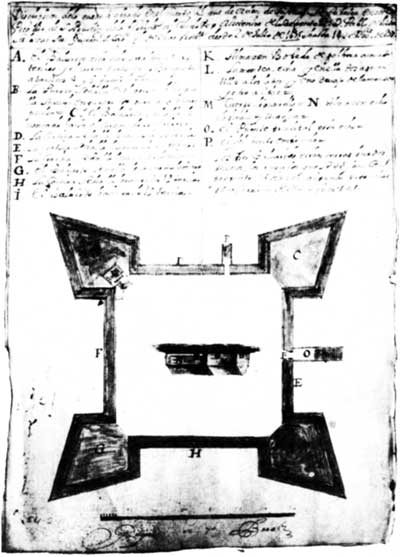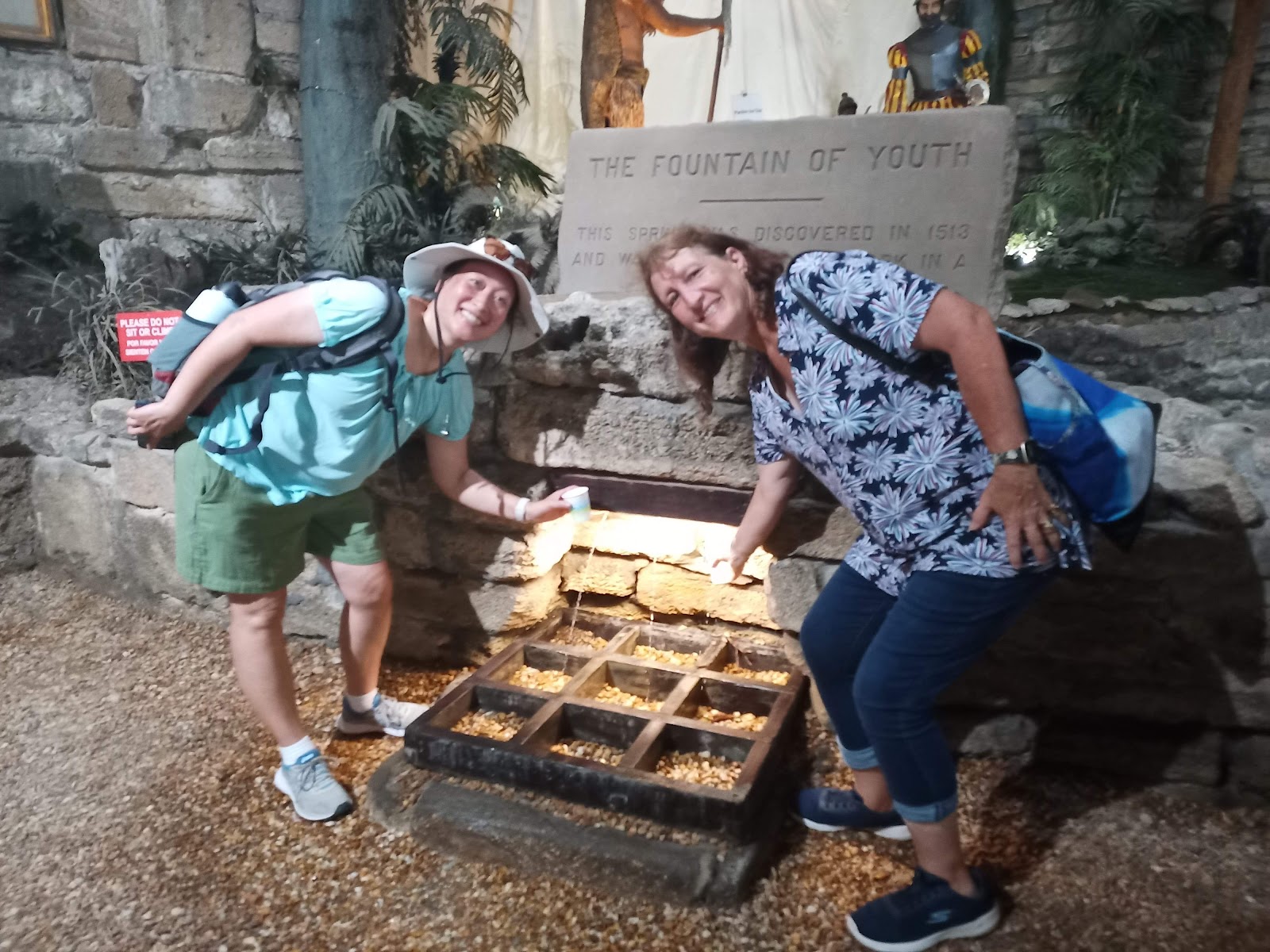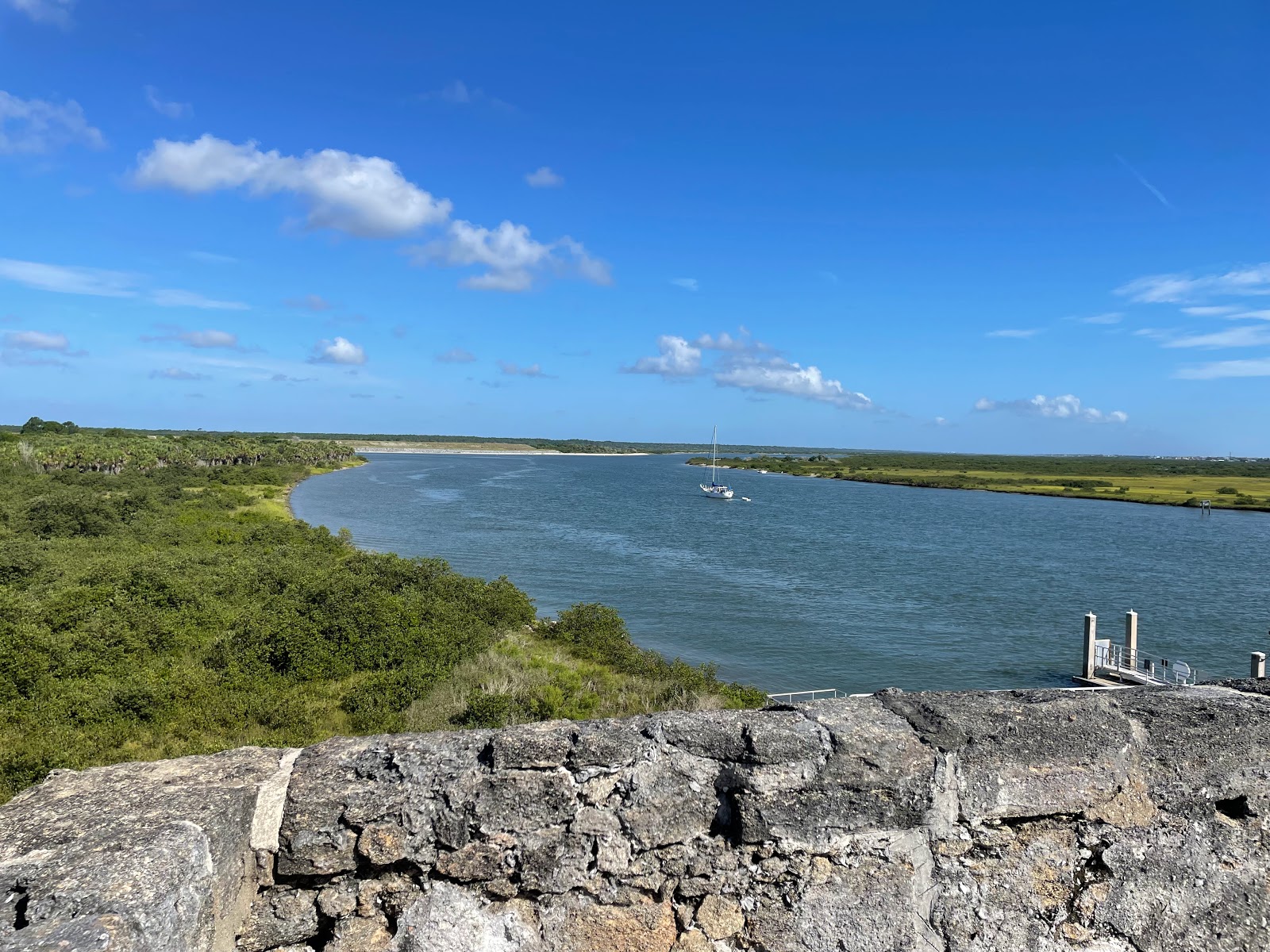My second teacher PD of the summer was again a space related workshop - "The Space Race on the Space Coast" - held at the Kennedy Space Center in Cape Canaveral, Florida. Now to be honest, I wasn't exactly thrilled to be visiting Florida, but I WAS excited to learn about the history of NASA and I was eager to visit the National Parks that happened to be located in Florida. So I connected with a teacher friend and planned a few extra days around our workshop to see the sights. I had met Joann the year before at another teacher seminar, and was glad that she was also eager to see some National Parks.
CASTILLO DE SAN MARCOS NATIONAL MONUMENT
Founded by the Spaniards in 1565, St. Augustine, Florida is the oldest continuously inhabited European settlement in the US. After earlier wooden forts were destroyed by English raids, construction on the coquina stone fort began in 1672. Coquina is a sedimentary rock made up of shells and limestone. It made for an excellent building material, since cannonballs that hit the fort did very little damage. Instead of shattering the walls, coquina stone compressed and absorbed the shock of the hit. |
| Construction plans, 1677 |
The Castillo sits right in downtown St. Augustine, at the mouth of the Matanzas River. We toured the inside of the fort and even got to see a cannon-fire demonstration!
Afterwards, we made a quick stop at the Fountain of Youth Archaeological Park, where Ponce de Leon supposedly landed in 1513 while looking for the Fountain of Youth.
Yes, we tasted the water. Blechhhhh.🤮
TIMUCUAN ECOLOGICAL & HISTORIC PRESERVE
Before the Europeans reached the new world, the native Timucua people lived in Northern Florida. Sadly, they were completely wiped out by the 1700s. This preserve protects not just the stories of the Timucuan, but the wetlands and marshes of northeastern Florida, the history of slaves at the Kingsley Plantation, and the French colony of Fort Caroline.
 |
| The row of slave houses at Kingsley Plantation |
Did you know that gopher tortoises dig long burrows that are home to more than 350 other species? They are one of the keystone species in the area, and it was so exciting to find one in its burrow!
 |
| Hello, gopher tortoise! I see you! |
Within the preserve is also Fort Caroline National Memorial.
Around the same time that the Spaniards were establishing themselves at St. Augustine, the French also sent small parties to settle in the New World and stake their claim on the riches they hoped to find. In 1562, Jean Ribault set off from France for the first expedition, erecting a monument near the mouth of the St. Johns River in 1564, Rene de Laudonniere (who had accompanied Ribault) established the first permanent settlement - La Caroline.
The 250+ colonists included artisans and women, many of whom were Huguenots (French Protestants) looking for religious freedom. They struggled in their first year, relying heavily on the Native Americans in the area. When Ribault returned from France in August 1565 to bring reinforcements, the Spanish decided to oust the French and maintain their stronghold in Florida. Ribault fled in his ships, but was thwarted by a violent storm. Meanwhile, another Spanish garrison traveled over land and attacked La Caroline. A few dozen people escaped, and of the remaining 200 only around 50 women and children were spared. Ribault surrendered to the Spanish but were executed as heretics. The location of the massacre is now called Matanzas - Spanish for 'slaughters.'
Even though the exact location of Fort Caroline is unknown, the replica - a small triangular fort - shows the small size of the ill-fated colony and gives a taste as to how the French had to defend themselves.
FORT MATANZAS NATIONAL MONUMENT
All this turmoil amongst the various factions meant each nation needed a way to protect its settlements. The Spanish, to help protect St. Augustine, knew they needed to keep tabs on the Matanzas Inlet, so a few years after the massacre, they began manning a wooden watchtower. The current coquina tower was completed in 1742 on tiny Rattlesnake Island in the middle of the inlet.
 A quick 5-minute boat tide took us to the Island, where we were allowed to wander through the tiny fort. I could easily imagine how the lazy days would be if I were one of the soldiers stationed sent for my 30-day stint... I'm sure there was a lot of fishing and swimming and card games... and not much else going on!
A quick 5-minute boat tide took us to the Island, where we were allowed to wander through the tiny fort. I could easily imagine how the lazy days would be if I were one of the soldiers stationed sent for my 30-day stint... I'm sure there was a lot of fishing and swimming and card games... and not much else going on!CANAVERAL NATIONAL SEASHORE
Before heading back to Orlando to meet up with the other teachers for the NEH seminar, Joann and I stopped off at the Canaveral National Seashore. It's an interesting place since much of it has no roads - and while it is the longest stretch of undeveloped land in Eastern Florida, the Kennedy Space Center and many of the launch pads are within the park boundaries. The road going down from New Smyrna (the northern end) stops at Apollo Beach - and while the timing wasn't right for us, I can only imagine how cool it would be to watch a rocket launch from the beach!!
Before Ponce de Leon and other Europeans came to Florida in the 1500s, the Timucuan people lived up and down the Florida coast, including at sites around Canaveral. We hiked around Turtle Mound, a shell midden from over 2000 years ago. We also saw a few gopher tortoises, which hopefully means they are rebounding from their threatened status!
 |
| Many of them had scars ☹️ |
 |
| While manatees are often solitary, they do congregate during breeding season and in pockets of warmer waters. We saw over 50 individuals from our viewing deck! |
KENNEDY SPACE CENTER
 |
| With Launch Director Mike Leinbach - the man who decides "Go" or "No Go!" |
Did you know? The main reason why the Kennedy Space Center is built on Cape Canaveral is because of location: Because of the rotation of the earth, rockets are always launched to the East - because the velocity of the earth's rotation is added to the speed of the rocket, giving it an extra push! And the velocity of the earth is faster near the equator than it is at the poles. And having a launch pad on the East coast means that in the event of an accident, debris will fall into the ocean instead of onto someone's house... so the most eastern/southern spot is Florida!
 |
| Saw my first horseshoe crab! |
 |
| The VAB: The doors on the sides are 456 feet high, so rockets are assembled vertically and rolled out! |
 |
| Launch Pad 39B: Ready for Artemis! |
 |
| The control center at LC-26 is now a museum |
The first US satellite was launched from LC-26A in 1958, and it was so cool seeing the computers used over 60 years ago to get an object up into space:
In 1962, America put John Glenn into orbit. The control center was located in a thick blockhouse bunker, which may or may not be where you'd want to be during the zombie apocalypse...
 |
| Just outside LC 14 |
 | |
|
 |
| A stamp on the side of the complex reads "Abandon in place," which means to abandon it without maintenance. |
 |
| One of the memorial plaques |
The complex was decommissioned after the launch of Apollo 7, the first crewed mission, in 1968.
 |
| The Atlantis shuttle exhibit was out of this world! |
 |
| With my new teacher friends Joann, Pam, and Rebecca! |
They did a fantastic job telling the NASA story and explaining why it matters, and I look forward to seeing what future exploration brings!













